Aim: Expand soloing arsenal by reworking some familiar ideas.
Level: Intermediate - Advanced
Previous knowledge helpful: Basic knowledge of modes.
Many of us guitarists started creating solos with the old faithful minor pentatonic scale (Figure 1). As fun as that seemed at the time, you probably eventually grew tired of the sound and wanted to increase your options when soloing. You could always "break out of the box" (always a good skill to have), but an option I often use is to build some better boxes instead.

Modal pentatonics are great to phrase with, they can give you a whole new set of licks just by adapting your existing pentatonic ideas (without your friends and band mates knowing!), and they allow you to highlight the sounds lurking within various modes with little work and great results. They're also very easy to customize based on your personal note choice preferences (very important!), but I will come to that later.
My aim (and hopefully yours) when using the modal pentatonic licks is to recreate the unique sounds of our chosen modes (I'll be using modes of the major scale in this installment), whilst keeping the convenience and familiarity of two note per string shapes (for now). Just as the minor pentatonic can be perceived as an abbreviation of the Minor scale or Aeolian mode, (i.e., some notes are omitted), the aim for our modal pentatonics is to bring to mind the sound of the other modes, only with fewer notes.
Let's start simply by working out what makes our minor pentatonic scale tick. In the key of A minor, the notes of the pentatonic scale are A, C, D, E and G, which are the 1st, 3rd, 4th, 5th and 7th of the A natural minor scale. Try Example 1 to get used to a pattern that we'll be adapting to all of our modal pentatonics soon. You can use your own pentatonics licks and sequences once you see where I'm going with this.

MP3 - Example 1
To get started with the modal possibilities, we're going to take that formula used to create the minor pentatonic (1,3,4,5,7) and apply it to each mode of the C Major scale. Let's cover the major sounding modes first. Applying the formula to the C Ionian (Mode 1) mode gives us the notes C,E,F,G,B, applying it to F Lydian (Mode 4) gives us F,A,B,C,E, and applying it to G Mixolydian (Mode 5) gives us G,B,C,D,F. Check out my personal fingerings for these in figures 2, 3 and 4.
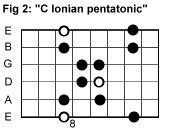
MP3 - Figure 2
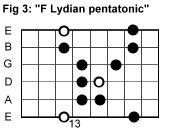
MP3 - Figure 3
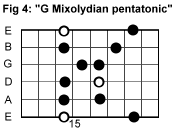
MP3 - Figure 4
After you've had a little play time with these new shapes, try adapting some licks that you normally play with the minor pentatonic scale, and take note of the cool new sounds at your disposal. Take a look at Examples 2, 3 and 4, which adapt Example 1 to the new shapes above. They sound great and far less predictable than the first lick. Be sure to try each lick over the chords listed for each example.

MP3 - Example 2

MP3 - Example 3

MP3 - Example 4
We have three modes left to go, but a slight problem arises. Adapting our 1,3,4,5,7 pattern to modes 2 (Dorian) and 3 (Phrygian) produces familiar shapes doesn't it? From these degrees of the scale we merely end up with the old faithful minor pentatonic shape starting on D (Figure 5) and E (Figure 6). Once again, you can adapt Example 1 to these positions with the chords listed, and while the sounds they produce are okay, they fail to represent their respective modes as well as they could. I will offer some alternatives to these in the next lesson, but in the meantime, include figures 5 (over a Dm7 chord) and 6 (over an Em7 chord) in your practice routine as you work through all of the modal pentatonics, and then you'll be ready for the improvements to come.

MP3 - Figure 5
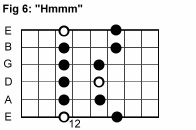
MP3 - Figure 6
Let's take a look at our last remaining mode of the Major scale - the B Locrian. Apply the 1,3,4,5,7 formula to this scale. What a difference a flat 5 makes! This new pattern (Figure 7) has a great oriental sound to it. Once again, try it with our adapted pattern (Example 5), over the recommended chord and enjoy.
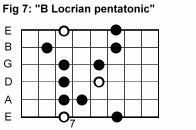
MP3 - Figure 7

MP3 - Example 5
As with all the good stuff, the light bulbs will glow when you put the ideas to use, so I thoroughly recommend creating some backing tracks and putting your new tools to good use. You may find that some of your old faithful licks aren't comfortable with the new shapes, but you may come up with a whole new batch of licks and ideas which feel and sound better, so experiment!
In the next lesson, I'll help you customize the modal pentatonics to suit your own tastes, cover my personal substitutions for modes 2 and 3 (and some of the others), give some less obvious examples of where you can apply modal pentatonics, and give you some examples of me jamming with them. Don't miss the fun.
See you next month!
Chris Brooks is an amazing Australian guitarist setting the instrumental guitar world on fire with his unique brand of progressive metal and fusion.
His instrumental CD is entitled "The Master Plan".